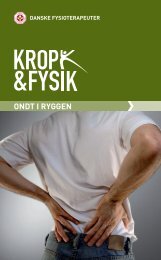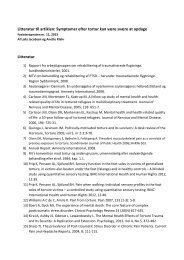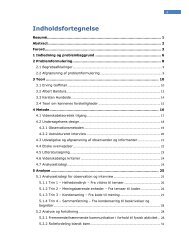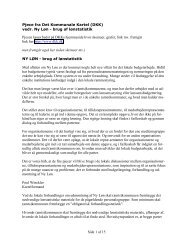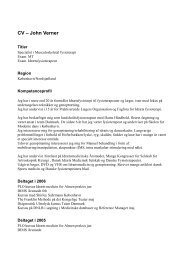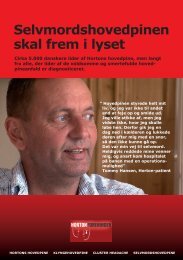Ulla Werlauff Methods to assess physical functioning - Danske ...
Ulla Werlauff Methods to assess physical functioning - Danske ...
Ulla Werlauff Methods to assess physical functioning - Danske ...
Create successful ePaper yourself
Turn your PDF publications into a flip-book with our unique Google optimized e-Paper software.
levels: subjective fatigue, concentration, motivation and <strong>physical</strong> activity. Both scales have been<br />
recommended for use in future studies on fatigue in neuromuscular disorders [ENMC 2011] <strong>to</strong><br />
further evaluate their applicability in these disorders.<br />
Very few studies have used qualitative interviews <strong>to</strong> address the experiences of living<br />
with a neuromuscular disease in terms of consequences for activity and participation, but two<br />
studies [Boström 2004, Heatwole 2012] emphasize that fatigue restricts activities of daily life.<br />
Qualitative interviews can be one of the first steps <strong>to</strong> develop a PRO instrument, but can also act as<br />
method <strong>to</strong> validate an existing instrument <strong>to</strong> assure that the concept of interest captures the concept<br />
from the patients’ perspective [Patrick 2011].<br />
THE TWO DIAGNOSES<br />
Congenital myopathy<br />
Congenital myopathies (CM) are a group of neuromuscular diseases in which symp<strong>to</strong>ms typically appear at birth or in<br />
infancy. The incidence and prevalence of CM is unknown. The diseases are caused by mutations in genes that encode<br />
proteins involved in the contractile function of muscle fibers and are grouped in four ‘‘morphological subclasses” based<br />
on features seen on muscle biopsy (myopathies with protein accumulations – e.g. rods, cores, central nuclei and fiber<br />
size variations) [North 2008]. Genes have been identified within each of the four subgroups, but finding the right<br />
genetic diagnosis has been complicated by the fact that one gene mutation can cause different his<strong>to</strong>logical features and<br />
different gene mutations can cause the same his<strong>to</strong>logical feature.<br />
The clinical presentation of the CMs is at a continuum of severity varying from a slight <strong>to</strong> severe impairment of<br />
<strong>physical</strong> function. Despite different genetic backgrounds, the phenotypes show great overlap among the different CMs<br />
although some clinical characteristics are specific for the individual type and may lead <strong>to</strong> genetic testing. As an<br />
example, does the finding of fiber size variation combined with early scoliosis and impaired respira<strong>to</strong>ry function<br />
indicate a SEPN1 mutation.<br />
The classical clinical features in CM are impaired muscle strength and delayed mo<strong>to</strong>r development with onset at birth or<br />
from early childhood. Mimics are often impaired resulting in ophthalmoparesis, p<strong>to</strong>sis and/ or bulbar involvements<br />
[Ryan 2001, Jungbluth 2005], but there is a great variability in the degree of these symp<strong>to</strong>ms and some types of CM do<br />
not affect facial muscles. In general, mo<strong>to</strong>r development progresses after the initial period of life, but then stabilizes.<br />
Some patients may, however experience a continuous loss of <strong>physical</strong> function or worsening of symp<strong>to</strong>ms later in the<br />
disease course. The degree and range of clinical symp<strong>to</strong>ms as well as the natural course of the diseases is still not well<br />
unders<strong>to</strong>od due <strong>to</strong> lack of data on the natural his<strong>to</strong>ry of the diseases.<br />
Despite being a heterogeneous group of disorders, some common impairments influence daily life in patients with<br />
congenital myopathies. Some frequent complaints are fatigue and low endurance [Wang 2012], but no systematic<br />
studies on these complaints have been conducted in this group of disorders.<br />
16




